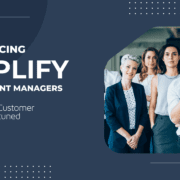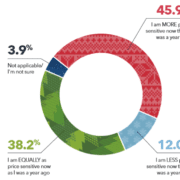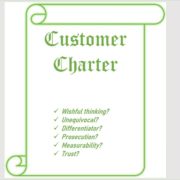Customer Centricity Corner with Peter Lavers – What Loyalty Means in Business to Business
What Loyalty means in Business to Business
Everyone who’s passionate about customer centricity would agree that loyalty is a good thing.
But when your customers are businesses rather than consumers, there are different factors and dynamics at play.
Peter Lavers, Co-founder and Customer Management Influencer, talks to Amanda Cromhout from Truth, a leading global loyalty consultancy, and Mark Maclure from Stream Loyalty, who are tech-enabled loyalty consultants.
In this discussion, they tackle the questions: What would you describe as good practice in B2B – initially thinking about ‘mainstream’ B2B, where a company has lots of moderate value business clients? What about in ‘big’ B2B – complex multi-year contracts and key accounts where most of the people your company deals with aren’t the decision makers?
Transcript:
Peter Lavers:
Hello and welcome to the Customer Centricity Corner, brought to you by Customer Attuned. My name is Peter Lavers
and in this series I’m discussing different aspects of customer centricity in the B2B sector with a range of experts and practitioners. Our
focus in these short, about twelve minute discussions, is on the practicalities of making customer centricity real rather
than it just being a theory or a set of good intentions that you want to do.
Our subject today is how to recognise and appreciate customer loyalty in the B2B context.
I’m delighted to introduce Amanda Cromhout from Truth, a leading global loyalty consultancy, and Mark Maclure from Stream Loyalty
who are a tech enabled loyalty consultants. Mark and Amanda, I think everyone who’s passionate about customer centricity would agree that loyalty is a good thing, when your customers are businesses, however, rather than consumers, there are different factors and dynamics at play.
What would you describe as good practise in B2B and initially thinking about kind of mainstream B2B, where a company has lots of kind of moderate value business clients?
Amanda:
I think if we think about the medium sized B2B rather than some of the big corporates, we’ve got to remember at the end
of the day there’s a lot of the individuals inside of those companies who will benefit from such a loyalty proposition. They’re consumers like you and me, so to speak.
But actually what you reward for will be obviously different than a consumer programme. So when you’re deciding on the benefit set,
there’s literature galore out there like we all know what appeals to yourself, we’ve got so much choice to pick from, but then at the end of
the day we also need to offer choice that’s relevant to help the business.
So you can have a suite of benefits that are interesting to me as an individual, as the recipient of a B2B loyalty proposition, but also a suite of benefits that are relevant for my business. But what you reward against is either transactional or there’s behavioural activities such as attending a training programme on the product so you can better sell it or better use it or better attend events that you’re hosting. So there’s behavioural and there’s transactional.
Mark:
Yeah, I concur with that. And we also build out our tech so that we can reward not just transactional behaviour but actions, which is probably much more relevant in the B2B world because you do have so many more stakeholders within a business who some of them are decision makers, some of them not decision makers, but they’re vested. And it’s all about understanding what behaviours you’re trying to influence and then how you reward those.
There are two parts to sort of loyalty is one is how you reward and then what you reward with. And of course you’ve got the complexities of:
- How do I make it?
- Who am I rewarding?
- Who makes the decision on that?
- Where does that go?
- Is it relevant?
- Do you have issues with what you can and can’t accept?
Should it be something that helps a customer’s sustainability criteria, so actually have it all about sustainability, or could it should it be giving them back a discount off a future transaction with you? So you’ve got so much more complexity than you have in the consumer world, wrapped up in the B2B world.
Peter:
So practically applying that, then, Mark, there’s the technology to gather the data, I guess, and actually then build that in, in that more complex kind of layered way.
Mark:
Well, as I like to say, there’s an old saying that engineers love, which is: “what gets measured, gets done,” and by the time taken, if anything, that you can measure that has a value to you as a business. Well, therefore, if it’s got a value to you, it’s got a certain behaviour can have an equal value to some sort of transaction.
For example, as Amanda said, you’re attending an event, coming on a training programme, you might be an engineering business where if everyone takes training on my equipment, I know that A gets it used and B gets it more likely to be replaced. Therefore that has a high value to me. There’s nothing to do with transactional behaviour. It’s actually I want you to attend a training course.
So it’s about understanding what is of a value to the business and if you can measure it, then a metric can be applied to it and a reward can then be applied to that metric. Does that make sense?
Peter:
Brilliant. Amanda, anything to add that?
Amanda:
No, I’ll just back it up. I mean, I have the luxury of being a judge on the International Loyalty Awards and we’ve seen, for example, brands like IBM win in the B2B space in the B2B category. Simply tuned into exactly what Mark’s just said. Some of the major activities around the programme that they won it for, is around this training empowering all those sales force to be able to sell more IBMs to more
companies and more people because they know how this piece of technology works because they went to training and they get rewarded for that over and above lots of other things, like more sales and so forth.
And that’s the transactional piece. But obviously there’s more than training, but Mark and I have both used that as an example because actually it’s one of the most powerful examples.
Peter:
Thanks for that. That’s really interesting because that’s a different spin on what people think about as kind of loyalty programmes. Can we switch our attention a little bit now, thinking about big B2B complex multi year contracts that companies are often tied into for
that period. Key accounts where the company gets a huge amount of its revenue from just a few of its key clients.
What do you think are the differences that nuances the ways of working with those companies in building and appreciating loyalty?
Amanda:
I think our favourite approach that we’ve had the luxury of being able to do with quite a few B2B clients in the bigger environment is
more around, almost coverteering, where you take a traditional sales approach, as you say, there’s less companies that you were dealing with, but you understand the amount of business they’re worth to you.
And your top segment, your Covert segment might have two companies in it, but they are so vastly different than, say, the next ten companies, who are vastly different from the long tail of, say, 200 companies. It might be as small as that. And in that coverteering, if you pull on we tend to overly simplify it as a value proposition, but if you pull on three levers, it’s the relationship. Whether it’s the
key account managers, your long tail of 200 customers maybe only have access to online or telephonic account management support.
But the top tier has access to the C suite and the next ten have access to a key account manager. So there’s the relationship side, there’s obviously the financial side. So if you’re hitting rebates and triggers, or if you’re doing early settlement agreements that are more favourable, you can be rewarded more handsomely and so on.
So the financial pieces are given, but it can be wrapped into this value proposition. And then there’s the servicing. So maybe if it’s a product that has a warranty, the higher tier gets the extended warranty. Rather than having to apply for more warranty cover or online ordering, you’ve got more capability in the BI reports that gets served back to you if you’re a higher tier. And if you’re in the long tail of the lower tiers, you get potentially a reduced view of the BI. So that’s something that we’ve done a lot of in really various companies, whether it’s in the electrical engineering environment, whether it’s in the farming environment, where it’s just vastly different types of customers.
But actually, as long as you understand the channel and you understand the complexity of that channel, you can make it worthwhile from a business point of view rather than almost a loyalty marketing point of view. You just go back to the roots of the business requirements
of servicing that company. So, for me, the bigger corporates is much more aligned to customer centricity principles than
maybe some of the smaller organisational loyalty structures.
Mark:
I’d back that up and say that it begins with understanding your customer, because they’re all different. And I think the word loyalty
people go back to a consumer perspective and think of something quite binary.
Buy something, get something. “Oh, that won’t work for our business, because it’s about relationships and complexity…” And absolutely it is. You just take your customer base in a business that’s going to be compared to a consumer brand, you’re going to have far less of
them, but they’re going to be way more valuable and they’re going to be incredibly different. Stretching from the top two or three key customers who in your preto rule, going to give you 80%, right, that way down your tail. And I think too many people go, “well, we don’t need to worry about that, we’ve got customers sorted, we’ve got key account managers.”
But actually, you do need to worry about that. For those key accounts, what can I give to them that makes them feel too special in the customer centricity so that becomes more of a membership benefits? What do I give you as my key customers? Whatever that
might be. Access to the C suite or could it be a number of different things in it and special events that you might invite them to, et cetera.
And then as you go down your tail, that’s where a good loyalty strategy will go. Well, how can I automate some of these things to support
my customer service team in building loyalty? And also understand that even within those big accounts, there’s going to be multiple touch points within the organisation. And some of them, when you were in a big contract, actually might be sort of agnostic or sort of
antagonistic to you. “I begrudgingly am your customer, because procurement have got a five year deal with you,”
so you have this weird thing, whereas in the consumer world, your loyalty is to a person and the emotions that go around it.
Whereas in the business world, I might not like dealing with you, but I have to through to I get a great customer experience from
you. So it’s about working out. I would literally think every business is different, so it’s about understanding what is the drivers in your business, what are the metrics that you can apply to those behaviours. And the bigger the business, it’s going to be more
around. I’ve got so many touch points in the organisation, so I need to reward the behaviours and then if I’m rewarding the behaviours, who gets to spend those rewards? So you’ve got all of that complexity and as I said earlier, you might be in a regulated
business, so I can’t be seen to be taking anything that looks like an inducement or a bribe or those things just don’t sit in our policies.
Well, that’s fine. There’ll be things that you can redeem them on, that could be services warranties or charitable donations. And there’s a lot going on in the sustainability agenda where if you can help your customer drive their sustainability agenda, then that’s going to be very positive in our drive towards net zero and it’s become a really big topic in the coming years. So I think the simple answer is know customers. There’s no one solution for one customer. It’s about understanding them and working out how you can help them keep the customers they’ve got.
Peter:
Brilliant. I think that’s a key takeaway from this that your strategy needs to reflect the different types and the different needs of customers. I really loved what I heard about what is a valuable that you want to recognise in some way, because it’s not just the revenue.
There are other things, there are behaviours, there are events, things like that, that you value, but for me, kind of underlying it all.
In the B2B space, we mustn’t take loyalty for granted, and I think that has come through as well. I’ve seen companies that do take particularly, as you said, Amanda, in that key account space. They do take loyalty for granted, but we mustn’t, particularly in the current environment.
So that concludes our discussion. What we’ve heard today fits really well with the purpose of Customer Attuned, which is to build a culture of customer centricity that’s based on trust to establish sustainable, mutually beneficial and profitable B2B relationships.
I hope that what you’ve heard today helps you on your customer centricity journey.
If you’d like to hear or find out more, please go to our website which is CustomerAttuned.com, where you can find link to Mark and Amanda’s websites the rest of the series, and also see what else we do at Customer Attuned.
Thank you for listening and thanks again, Amanda and Mark, for speaking today.
- Customer Strategy in the B2B Membership Sector - May 27, 2025
- Build a B2B Customer Strategy - May 20, 2025
- Should you implement NPS in B2B? - January 22, 2025




